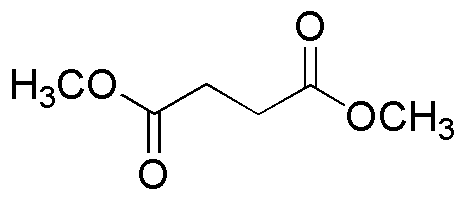Dimethyl succinate is widely utilized in research focused on:
- Solvent Applications: It serves as an effective solvent in various chemical reactions and formulations, particularly in the production of coatings, adhesives, and inks, enhancing the performance of these products.
- Flavor and Fragrance Industry: This compound is used as a flavoring agent and fragrance component, providing a fruity aroma in food products and perfumes, making it popular in the culinary and cosmetic sectors.
- Polymer Production: Dimethyl succinate is a key building block in the synthesis of biodegradable polymers, which are increasingly important in reducing plastic waste and promoting sustainability in packaging and materials.
- Pharmaceuticals: It plays a role in the synthesis of various pharmaceutical compounds, contributing to the development of effective medications and therapies, particularly in the field of drug delivery systems.
- Biofuel Development: The compound is explored as a potential intermediate in the production of biofuels, offering a renewable alternative to fossil fuels and aligning with global sustainability goals.
Informations générales
Propriétés
Sécurité et réglementation
Applications
Dimethyl succinate is widely utilized in research focused on:
- Solvent Applications: It serves as an effective solvent in various chemical reactions and formulations, particularly in the production of coatings, adhesives, and inks, enhancing the performance of these products.
- Flavor and Fragrance Industry: This compound is used as a flavoring agent and fragrance component, providing a fruity aroma in food products and perfumes, making it popular in the culinary and cosmetic sectors.
- Polymer Production: Dimethyl succinate is a key building block in the synthesis of biodegradable polymers, which are increasingly important in reducing plastic waste and promoting sustainability in packaging and materials.
- Pharmaceuticals: It plays a role in the synthesis of various pharmaceutical compounds, contributing to the development of effective medications and therapies, particularly in the field of drug delivery systems.
- Biofuel Development: The compound is explored as a potential intermediate in the production of biofuels, offering a renewable alternative to fossil fuels and aligning with global sustainability goals.
Documents
Fiches de données de sécurité (FDS)
La FDS fournit des informations de sécurité complètes sur la manipulation, le stockage et l’élimination du produit.
Spécifications du produit (PS)
Le PS fournit une description complète des propriétés du produit, notamment sa composition chimique, son état physique, sa pureté et les exigences de stockage. Il détaille également les plages de qualité acceptables et les applications prévues du produit.
Certificats d'analyse (COA)
Recherchez des certificats d'analyse (COA) en saisissant le numéro de lot du produit. Les numéros de lot et de lot se trouvent sur l'étiquette d'un produit, après les mots « Lot » ou « Lot de fabrication ».
Numéro de catalogue
Numéro de lot/série
Certificats d'origine (COO)
Ce certificat d'exploitation confirme le pays dans lequel le produit a été fabriqué, et détaille également les matériaux et composants utilisés et s'il est issu de sources naturelles, synthétiques ou autres sources spécifiques. Ce certificat peut être requis pour les douanes, le commerce et la conformité réglementaire.
Numéro de catalogue
Numéro de lot/série
Fiches de données de sécurité (FDS)
La FDS fournit des informations de sécurité complètes sur la manipulation, le stockage et l’élimination du produit.
DownloadSpécifications du produit (PS)
Le PS fournit une description complète des propriétés du produit, notamment sa composition chimique, son état physique, sa pureté et les exigences de stockage. Il détaille également les plages de qualité acceptables et les applications prévues du produit.
DownloadCertificats d'analyse (COA)
Recherchez des certificats d'analyse (COA) en saisissant le numéro de lot du produit. Les numéros de lot et de lot se trouvent sur l'étiquette d'un produit, après les mots « Lot » ou « Lot de fabrication ».
Numéro de catalogue
Numéro de lot/série
Certificats d'origine (COO)
Ce certificat d'exploitation confirme le pays dans lequel le produit a été fabriqué, et détaille également les matériaux et composants utilisés et s'il est issu de sources naturelles, synthétiques ou autres sources spécifiques. Ce certificat peut être requis pour les douanes, le commerce et la conformité réglementaire.

